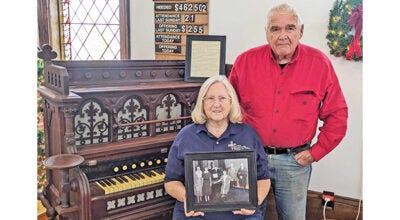Kathee Kiesselbach: Niles artist gives botanicals the right touch
Published 8:00 am Wednesday, January 9, 2013
Sandy Williams, who hales from a long line of gardeners, finds inspiration for her work from her own garden.
“I only drew horses in grade school, but was singled out as the best artist in the class,” she told me about her early artwork.
Williams, who moved to Southwestern Michigan as a toddler with her family has stayed in Niles, living on the old family homestead where her grandparents once lived on 15 acres. Her studio is in the house and it is there that she works. Her grandmother, Olive Williams, was well known as a local herb lady who gave talks at Fernwood Botanical Garden and Nature Preserve.
Williams attended Western Michigan University and studied art history, later taking art classes at Southwestern Michigan College. She attended Indiana University South Bend thinking she wanted to teach art but decided to study fine art under painter and local legend Harold Zisla, who introduced her to opaque watercolor paint, called gouache. Because it was not possible to master gouache in one class, she mastered that skill on her own. She joined the Guild of Natural Science Illustrators to learn how to enter shows and competitions and read their newsletters and other publications.
Williams worked part time through her 20s while she worked on her art. Asked if it was tough to stick with it without feeling isolated, she told me, “I had my mother and grandmother for inspiration.”
Williams’ favorite things to paint are birds, always drawn from photographs. She also does botanicals, and total ecosystem scenes, like everything you would see in June or October or a slice of one spring day condensed into a very small area, or particular locations such as wetlands or mountains. She came up with the idea to do ecosystem scenes in 2000 when she was trying to think of something special for the millennium.
She came up with spring, summer, fall and winter. Painted on a 22-by-29-inch full sheet of Arches watercolor paper, “Spring Woodland, “complete with ferns, is one of the pieces in a coming exhibit at Fernwood. Williams has done a wildflower series, showing thistle, blood root, May apple, golden rod and Queen Ann’s lace, all common in the Michiana area.
With a portfolio of hundreds of greeting cards, Williams has signed with Looking Good Licensing in Vermont, which handles marketing of cards, puzzles, printed tins and other products on which her artwork will appear. She has sold designs to companies such as Yankee Candle.
“I advise students I teach,” Williams told me, “to think thousands of years into the future when many plants we see every day are extinct. These illustrations may be the only visual images left. So students should illustrate the plant at different angles, and at different times of the year.”
Williams does not work from photos here, as she likes to get the best angles and light by using live specimens under a combination lamp to her left because she is right handed. She uses hot press Arches, a French watercolor paper and Windsor Newton gouache. She does a sketchy drawing, and then starts painting with gouache. She does the lower layers with a thin wash, and then adds layers, using thicker paint as she goes.
“The paint becomes a creamy layer and that’s when I know it’s the right consistency to give it the three-dimensionality I want; that realism,” said Williams, explaining some visitors to her studio have tried to pick up a plant off a flat piece of paper because they thought it was real. She uses teensy, tiny 18 zero, 20 zero brushes; more than a few hairs, but really small. She uses a tiny bit of water, the point being to get a creamy consistency. On some of the uppermost layers, she may use nearly a dry brush technique.
“I’d like to further develop my ecosystem series, by doing the western mountains and plains, with buffalo and prairie dogs, and to continue doing botanicals.”
She will continue teaching and exhibiting her work as well.





